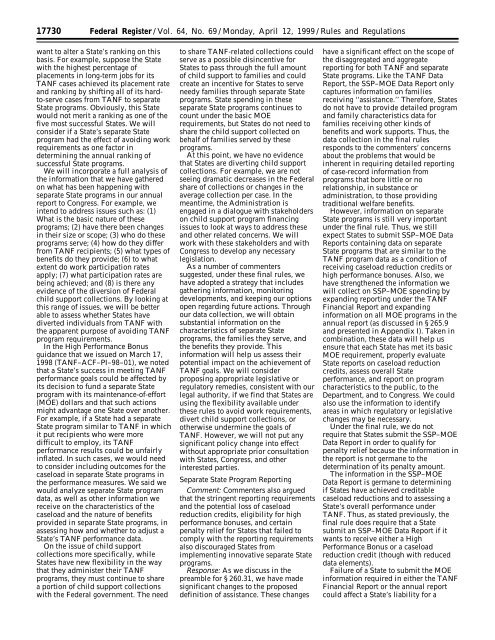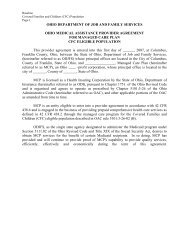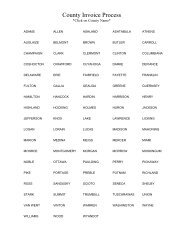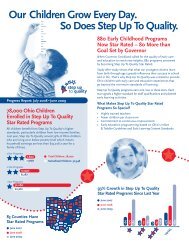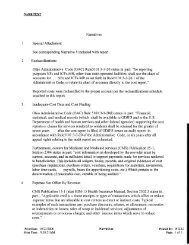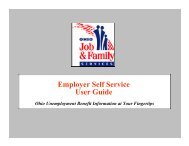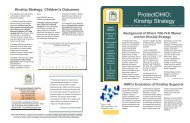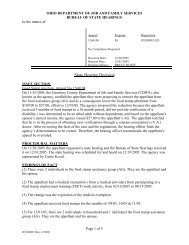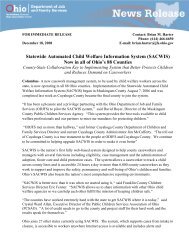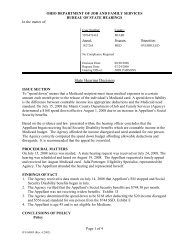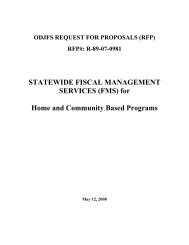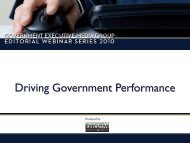Final TANF Rule as published in the Federal Register 4/12/1999
Final TANF Rule as published in the Federal Register 4/12/1999
Final TANF Rule as published in the Federal Register 4/12/1999
You also want an ePaper? Increase the reach of your titles
YUMPU automatically turns print PDFs into web optimized ePapers that Google loves.
17730 <strong>Federal</strong> <strong>Register</strong> / Vol. 64, No. 69 / Monday, April <strong>12</strong>, <strong>1999</strong> / <strong>Rule</strong>s and Regulations<br />
want to alter a State’s rank<strong>in</strong>g on this<br />
b<strong>as</strong>is. For example, suppose <strong>the</strong> State<br />
with <strong>the</strong> highest percentage of<br />
placements <strong>in</strong> long-term jobs for its<br />
<strong>TANF</strong> c<strong>as</strong>es achieved its placement rate<br />
and rank<strong>in</strong>g by shift<strong>in</strong>g all of its hardto-serve<br />
c<strong>as</strong>es from <strong>TANF</strong> to separate<br />
State programs. Obviously, this State<br />
would not merit a rank<strong>in</strong>g <strong>as</strong> one of <strong>the</strong><br />
five most successful States. We will<br />
consider if a State’s separate State<br />
program had <strong>the</strong> effect of avoid<strong>in</strong>g work<br />
requirements <strong>as</strong> one factor <strong>in</strong><br />
determ<strong>in</strong><strong>in</strong>g <strong>the</strong> annual rank<strong>in</strong>g of<br />
successful State programs.<br />
We will <strong>in</strong>corporate a full analysis of<br />
<strong>the</strong> <strong>in</strong>formation that we have ga<strong>the</strong>red<br />
on what h<strong>as</strong> been happen<strong>in</strong>g with<br />
separate State programs <strong>in</strong> our annual<br />
report to Congress. For example, we<br />
<strong>in</strong>tend to address issues such <strong>as</strong>: (1)<br />
What is <strong>the</strong> b<strong>as</strong>ic nature of <strong>the</strong>se<br />
programs; (2) have <strong>the</strong>re been changes<br />
<strong>in</strong> <strong>the</strong>ir size or scope; (3) who do <strong>the</strong>se<br />
programs serve; (4) how do <strong>the</strong>y differ<br />
from <strong>TANF</strong> recipients; (5) what types of<br />
benefits do <strong>the</strong>y provide; (6) to what<br />
extent do work participation rates<br />
apply; (7) what participation rates are<br />
be<strong>in</strong>g achieved; and (8) is <strong>the</strong>re any<br />
evidence of <strong>the</strong> diversion of <strong>Federal</strong><br />
child support collections. By look<strong>in</strong>g at<br />
this range of issues, we will be better<br />
able to <strong>as</strong>sess whe<strong>the</strong>r States have<br />
diverted <strong>in</strong>dividuals from <strong>TANF</strong> with<br />
<strong>the</strong> apparent purpose of avoid<strong>in</strong>g <strong>TANF</strong><br />
program requirements.<br />
In <strong>the</strong> High Performance Bonus<br />
guidance that we issued on March 17,<br />
1998 (<strong>TANF</strong>–ACF–PI–98–01), we noted<br />
that a State’s success <strong>in</strong> meet<strong>in</strong>g <strong>TANF</strong><br />
performance goals could be affected by<br />
its decision to fund a separate State<br />
program with its ma<strong>in</strong>tenance-of-effort<br />
(MOE) dollars and that such actions<br />
might advantage one State over ano<strong>the</strong>r.<br />
For example, if a State had a separate<br />
State program similar to <strong>TANF</strong> <strong>in</strong> which<br />
it put recipients who were more<br />
difficult to employ, its <strong>TANF</strong><br />
performance results could be unfairly<br />
<strong>in</strong>flated. In such c<strong>as</strong>es, we would need<br />
to consider <strong>in</strong>clud<strong>in</strong>g outcomes for <strong>the</strong><br />
c<strong>as</strong>eload <strong>in</strong> separate State programs <strong>in</strong><br />
<strong>the</strong> performance me<strong>as</strong>ures. We said we<br />
would analyze separate State program<br />
data, <strong>as</strong> well <strong>as</strong> o<strong>the</strong>r <strong>in</strong>formation we<br />
receive on <strong>the</strong> characteristics of <strong>the</strong><br />
c<strong>as</strong>eload and <strong>the</strong> nature of benefits<br />
provided <strong>in</strong> separate State programs, <strong>in</strong><br />
<strong>as</strong>sess<strong>in</strong>g how and whe<strong>the</strong>r to adjust a<br />
State’s <strong>TANF</strong> performance data.<br />
On <strong>the</strong> issue of child support<br />
collections more specifically, while<br />
States have new flexibility <strong>in</strong> <strong>the</strong> way<br />
that <strong>the</strong>y adm<strong>in</strong>ister <strong>the</strong>ir <strong>TANF</strong><br />
programs, <strong>the</strong>y must cont<strong>in</strong>ue to share<br />
a portion of child support collections<br />
with <strong>the</strong> <strong>Federal</strong> government. The need<br />
to share <strong>TANF</strong>-related collections could<br />
serve <strong>as</strong> a possible dis<strong>in</strong>centive for<br />
States to p<strong>as</strong>s through <strong>the</strong> full amount<br />
of child support to families and could<br />
create an <strong>in</strong>centive for States to serve<br />
needy families through separate State<br />
programs. State spend<strong>in</strong>g <strong>in</strong> <strong>the</strong>se<br />
separate State programs cont<strong>in</strong>ues to<br />
count under <strong>the</strong> b<strong>as</strong>ic MOE<br />
requirements, but States do not need to<br />
share <strong>the</strong> child support collected on<br />
behalf of families served by <strong>the</strong>se<br />
programs.<br />
At this po<strong>in</strong>t, we have no evidence<br />
that States are divert<strong>in</strong>g child support<br />
collections. For example, we are not<br />
see<strong>in</strong>g dramatic decre<strong>as</strong>es <strong>in</strong> <strong>the</strong> <strong>Federal</strong><br />
share of collections or changes <strong>in</strong> <strong>the</strong><br />
average collection per c<strong>as</strong>e. In <strong>the</strong><br />
meantime, <strong>the</strong> Adm<strong>in</strong>istration is<br />
engaged <strong>in</strong> a dialogue with stakeholders<br />
on child support program f<strong>in</strong>anc<strong>in</strong>g<br />
issues to look at ways to address <strong>the</strong>se<br />
and o<strong>the</strong>r related concerns. We will<br />
work with <strong>the</strong>se stakeholders and with<br />
Congress to develop any necessary<br />
legislation.<br />
As a number of commenters<br />
suggested, under <strong>the</strong>se f<strong>in</strong>al rules, we<br />
have adopted a strategy that <strong>in</strong>cludes<br />
ga<strong>the</strong>r<strong>in</strong>g <strong>in</strong>formation, monitor<strong>in</strong>g<br />
developments, and keep<strong>in</strong>g our options<br />
open regard<strong>in</strong>g future actions. Through<br />
our data collection, we will obta<strong>in</strong><br />
substantial <strong>in</strong>formation on <strong>the</strong><br />
characteristics of separate State<br />
programs, <strong>the</strong> families <strong>the</strong>y serve, and<br />
<strong>the</strong> benefits <strong>the</strong>y provide. This<br />
<strong>in</strong>formation will help us <strong>as</strong>sess <strong>the</strong>ir<br />
potential impact on <strong>the</strong> achievement of<br />
<strong>TANF</strong> goals. We will consider<br />
propos<strong>in</strong>g appropriate legislative or<br />
regulatory remedies, consistent with our<br />
legal authority, if we f<strong>in</strong>d that States are<br />
us<strong>in</strong>g <strong>the</strong> flexibility available under<br />
<strong>the</strong>se rules to avoid work requirements,<br />
divert child support collections, or<br />
o<strong>the</strong>rwise underm<strong>in</strong>e <strong>the</strong> goals of<br />
<strong>TANF</strong>. However, we will not put any<br />
significant policy change <strong>in</strong>to effect<br />
without appropriate prior consultation<br />
with States, Congress, and o<strong>the</strong>r<br />
<strong>in</strong>terested parties.<br />
Separate State Program Report<strong>in</strong>g<br />
Comment: Commenters also argued<br />
that <strong>the</strong> str<strong>in</strong>gent report<strong>in</strong>g requirements<br />
and <strong>the</strong> potential loss of c<strong>as</strong>eload<br />
reduction credits, eligibility for high<br />
performance bonuses, and certa<strong>in</strong><br />
penalty relief for States that failed to<br />
comply with <strong>the</strong> report<strong>in</strong>g requirements<br />
also discouraged States from<br />
implement<strong>in</strong>g <strong>in</strong>novative separate State<br />
programs.<br />
Response: As we discuss <strong>in</strong> <strong>the</strong><br />
preamble for § 260.31, we have made<br />
significant changes to <strong>the</strong> proposed<br />
def<strong>in</strong>ition of <strong>as</strong>sistance. These changes<br />
have a significant effect on <strong>the</strong> scope of<br />
<strong>the</strong> disaggregated and aggregate<br />
report<strong>in</strong>g for both <strong>TANF</strong> and separate<br />
State programs. Like <strong>the</strong> <strong>TANF</strong> Data<br />
Report, <strong>the</strong> SSP–MOE Data Report only<br />
captures <strong>in</strong>formation on families<br />
receiv<strong>in</strong>g ‘‘<strong>as</strong>sistance.’’ Therefore, States<br />
do not have to provide detailed program<br />
and family characteristics data for<br />
families receiv<strong>in</strong>g o<strong>the</strong>r k<strong>in</strong>ds of<br />
benefits and work supports. Thus, <strong>the</strong><br />
data collection <strong>in</strong> <strong>the</strong> f<strong>in</strong>al rules<br />
responds to <strong>the</strong> commenters’ concerns<br />
about <strong>the</strong> problems that would be<br />
<strong>in</strong>herent <strong>in</strong> requir<strong>in</strong>g detailed report<strong>in</strong>g<br />
of c<strong>as</strong>e-record <strong>in</strong>formation from<br />
programs that bore little or no<br />
relationship, <strong>in</strong> substance or<br />
adm<strong>in</strong>istration, to those provid<strong>in</strong>g<br />
traditional welfare benefits.<br />
However, <strong>in</strong>formation on separate<br />
State programs is still very important<br />
under <strong>the</strong> f<strong>in</strong>al rule. Thus, we still<br />
expect States to submit SSP–MOE Data<br />
Reports conta<strong>in</strong><strong>in</strong>g data on separate<br />
State programs that are similar to <strong>the</strong><br />
<strong>TANF</strong> program data <strong>as</strong> a condition of<br />
receiv<strong>in</strong>g c<strong>as</strong>eload reduction credits or<br />
high performance bonuses. Also, we<br />
have streng<strong>the</strong>ned <strong>the</strong> <strong>in</strong>formation we<br />
will collect on SSP–MOE spend<strong>in</strong>g by<br />
expand<strong>in</strong>g report<strong>in</strong>g under <strong>the</strong> <strong>TANF</strong><br />
F<strong>in</strong>ancial Report and expand<strong>in</strong>g<br />
<strong>in</strong>formation on all MOE programs <strong>in</strong> <strong>the</strong><br />
annual report (<strong>as</strong> discussed <strong>in</strong> § 265.9<br />
and presented <strong>in</strong> Appendix I). Taken <strong>in</strong><br />
comb<strong>in</strong>ation, <strong>the</strong>se data will help us<br />
ensure that each State h<strong>as</strong> met its b<strong>as</strong>ic<br />
MOE requirement, properly evaluate<br />
State reports on c<strong>as</strong>eload reduction<br />
credits, <strong>as</strong>sess overall State<br />
performance, and report on program<br />
characteristics to <strong>the</strong> public, to <strong>the</strong><br />
Department, and to Congress. We could<br />
also use <strong>the</strong> <strong>in</strong>formation to identify<br />
are<strong>as</strong> <strong>in</strong> which regulatory or legislative<br />
changes may be necessary.<br />
Under <strong>the</strong> f<strong>in</strong>al rule, we do not<br />
require that States submit <strong>the</strong> SSP–MOE<br />
Data Report <strong>in</strong> order to qualify for<br />
penalty relief because <strong>the</strong> <strong>in</strong>formation <strong>in</strong><br />
<strong>the</strong> report is not germane to <strong>the</strong><br />
determ<strong>in</strong>ation of its penalty amount.<br />
The <strong>in</strong>formation <strong>in</strong> <strong>the</strong> SSP–MOE<br />
Data Report is germane to determ<strong>in</strong><strong>in</strong>g<br />
if States have achieved creditable<br />
c<strong>as</strong>eload reductions and to <strong>as</strong>sess<strong>in</strong>g a<br />
State’s overall performance under<br />
<strong>TANF</strong>. Thus, <strong>as</strong> stated previously, <strong>the</strong><br />
f<strong>in</strong>al rule does require that a State<br />
submit an SSP–MOE Data Report if it<br />
wants to receive ei<strong>the</strong>r a High<br />
Performance Bonus or a c<strong>as</strong>eload<br />
reduction credit (though with reduced<br />
data elements).<br />
Failure of a State to submit <strong>the</strong> MOE<br />
<strong>in</strong>formation required <strong>in</strong> ei<strong>the</strong>r <strong>the</strong> <strong>TANF</strong><br />
F<strong>in</strong>ancial Report or <strong>the</strong> annual report<br />
could affect a State’s liability for a


